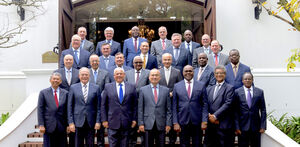An appeal to make children welcome
Children are our future—and yet they themselves often have no future. How are children doing in our day? And what do they need in order to have a better future? Here we take inventory to mark a very special day.

Sixty years ago, on 21 September 1954, the United Nations established International Children’s Day. Today it is observed in more than 145 nations on various dates, mostly between June and October. In Germany and Austria it will take place this Sunday. The Children’s Aid agency of the United Nations, known as UNICEF, has declared 20 November as the International Day of Children’s Rights.
The objectives of this day are the same everywhere, however: children cannot defend themselves, and are dependent on the help and support of society. The intent is to create awareness of the need for child protection and children’s rights. Standing up for children—this cannot remain confined to wishful thinking but is to be reflected in tangible and specific modes of behaviour. Many people find it difficult to even imagine that there are children who neither have access to school nor any education in general, that there are children who have to go hungry, or that there are children who are abused as child soldiers.
Avoidable mortality rates
The high mortality rate is scandalous. According to UNICEF there are approximately six million children under the age of five who die each year, most of them from malnutrition or avoidable illnesses. Forty per cent of these do not even live to be a month old. Most child deaths occur in sub-Saharan Africa and in South Asia, especially in India, Nigeria, the Democratic Republic of Congo, Pakistan, and Ethiopia. Lack of hygiene, poor health care in the general populace, and high poverty rates are just some of the causes.
Malawi is one of the positive exceptions: within the space of twenty years, it has been possible to lower the child mortality rate there by nearly half. The measures introduced included raising the number of midwives, introducing a significantly improved immunization programme, and investing in improved child nutrition.
Certainly the child mortality rate is on the decline. A lot has happened over the last years. But one thing that is still lacking in many places is access to clean drinking water. Every well that is constructed brings clean drinking water upward and gives life to children. According to the World Health Organization (WHO), one in three child deaths can be traced back to environmental damage.
Every five seconds, a little child dies somewhere in the world. And the experts agree that in most cases, this tragedy could be prevented. And the solutions are simple and inexpensive: immunization, antibiotics, mosquito nets, and improved care of mothers and children during and after birth.
Water is life
A lot is being done as well. For example, in Zimbabwe, the New Apostolic aid agency NAK-karitativ continually supports the construction of wells for drinking water. Only recently the St. Agnes children's home in Gokwe was equipped with a well that operates with a solar-powered water pump. Now the fresh water is making it possible to grow fruit and vegetables. These in turn provide healthier nutrition and variety on the menu. In March of this year, NAK-karitativ announced its participation in World Water Day.
And the Missionswerk of the New Apostolic Church in Southern Germany also sees itself as a well-builder. Particularly in the West African countries of Benin, Ghana, and Togo, wells are being drilled and equipped with pumps and filters using donated funds. This makes it possible to avoid waterborne diseases, in other words, infections that result from contaminated drinking water. Well projects make up a large proportion of the funding lists.
Help for children helps us all
Certainly there is not always an easy solution for assuring the survival of children. However, it is clear that the greatest progress has been made in those countries where governments have invested specifically in health care for the poorest families, clean drinking water, and in education and strategies for combatting poverty. The key lies in immunization campaigns, clean drinking water, and education.
Even those children who make it through need our support. UNESCO, among others, laments the shortage of education opportunities for children in many nations of the world. The Education for Children in Need programme alone manages over 400 projects in 97 countries affected by poverty, war, or natural disasters. All of these projects help people help themselves.
What can we do? Make children welcome in this world!
UN Photo/JC McIlwaine




